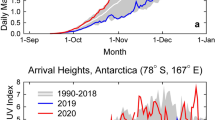Abstract
Based on atmospheric chemical kinetics, the rate constant of overall pseudo-first order oxidation removal of gaseous pollutants (K por,T ) is proposed to characterize the atmospheric oxidation capacity in troposphere. Being a quantitative parameter, K por,T can be used to address the issues related to atmospheric oxidation capacity. By applying this method, the regional oxidation capacity of the atmosphere in Pearl River Delta (PRD) is numerically simulated based on CBM-IV chemical mechanism. Results show the significant spatio-temporal variation of the atmospheric oxidation capacity in PRD. It is found that OH initiated oxidations, heterogeneous oxidation of SO2, and photolysis of aldehydes are the three most important oxidation processes influencing the atmospheric oxidation capacity in PRD.
Similar content being viewed by others
References
Thompson A M. The oxidizing capacity of the Earth’s atmosphere: Probable past and future changes. Science, 1992, 256: 1157–1165
Prinn G R. Ozone, hydroxyl radical and oxidative capacity. Treatise Geochem, 2003, 4: 1–19
Muller J F, Vinckier C, Peeters J. Arijs E. Anthropogenic and biogenic influences on the oxidation capacity of the atmosphere. SPSD II-Part 2-Global Change, ecosystems and biodiversity. 2005
Bloss W J, Evans M J, Lee J D, Sommariva R, Heard D E, Pilling M J. The oxidative capacity of the troposphere: Coupling of field measurements of OH and a global chemistry transport model. Faraday Discuss, 2005, 130: 425–436
Levy H. Normal atmosphere: large radical and formaldehyde concentrations predicted. Science, 1971, 173: 141–143
Zhang Y H, Shao K S, Tang X Y, Li J L. The study of urban photochemical smog pollution in China (in Chinese). Acta Scientiarum Naturalium, Universitat is Pekinensis, 1998, 34(2–3): 392–400
Wang S L, Zhang Y H, Zhong L J, Li J L, Yu Q. Interaction of urban air pollution among cities in Zhujiang Delta (in Chinese). Chin Environ Sci, 2005, 25(2): 133–137
Shao M, Tang X Y, Zhang Y H. Li W J. City clusters in China: Air and surface water pollution. Front Ecol Environ, 2006, 4(7): 353–361
Zhu T. Air Pollution Complex at Urban and Regional Scale (Chemistry Progress Series—Environmental Chemistry). Beijing: Chemical Industry Press, 2005
Jacob D. Heterogeneous chemistry and tropospheric ozone. Atmos Environ, 2000, 34: 2132–2159
Holland F, Aschmutat U, Hessling M, Hofzumahaus A, Ehhalt D H. Highly time resolved measurements of OH during the POPCORN using laser-induced fluorescence spectroscopy. J Atmos Chem, 1998, 31: 205–225
Mauldin III R L, Frost G J, Chen G, Tanner D J, Prevot A S H, Davis D D, Eisele F L. OH measurements during the first aerosol characterization experiment (ACE 1): Observations and model comparisons. J Geophys Res, 1998, 103(D13): 16713–16729
Pan X M, Chen S M, Hou H Q. Determination of OH free radical concentration in atmosphere (in Chinese). Shanghai Environ Sci, 1999, 18(2): 59–61
Ren X R, Shao K S, Tang S Y. Measurement of gas-phase OH using liquid phase scrubbing and high performance liquid chromatography (in Chinese). Environ Chem, 2001, 20(1): 81–85
Shao M, Ren X R, Wang H X, Zeng L M, Zhang Y H, Tang X Y. Quantitative relationship between production and removal of OH and HO2 radicals in urban atmosphere. Chin Sci Bull, 2004, 49(21): 2253–2258
Platt U, Winer A M, Biermann H W, Atkinson R, Pitts Jr J N. Environ Sci Technol, 1984, 18: 365–369
Prinn G R. The cleansing capacity of the atmosphere. Ann Rev Environ Resour, 2003, 28: 29–57
Cheng Y L, Bai Y H, Li J L, Liu Z R. A numerical simulation study of contribution of varions anthropogenic sources to ozone formation in Pearl River Delta region. Acta Scientiae Circumstantiae, 2008, 28(4): 791–798
Gery M W, Whitten G Z, Killus J P. Development and testing of CBM-IV for urban and regional modeling. U S Environmental Protection Agency, EPA-600/3-88-012, 1988
Joseph A L, Seinfeld J H. Analysis of the characteristics of complex chemical reaction mechanisms: application to photochemical smog chemistry. Environ Sci Tech, 1984, 18: 280–287
Author information
Authors and Affiliations
Corresponding author
Additional information
Supported by the National Basic Research Program of China (Grant Nos: 2005CB422204, 2002CB410802, and 2002CB410801)
Rights and permissions
About this article
Cite this article
Cheng, Y., Wang, X., Liu, Z. et al. A new method for quantitatively characterizing atmospheric oxidation capacity. Sci. China Ser. B-Chem. 51, 1102–1109 (2008). https://doi.org/10.1007/s11426-008-0119-z
Received:
Accepted:
Published:
Issue Date:
DOI: https://doi.org/10.1007/s11426-008-0119-z




